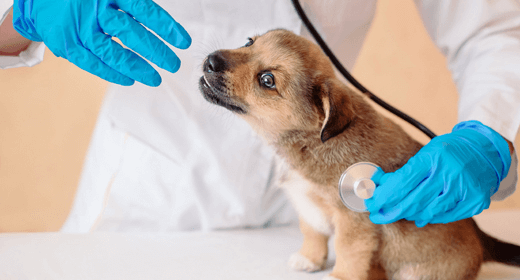

Your puppy's first visit to the vet will probably be more than just a quick hello. Get all the details from Veterinarian Dr. Katy Nelson as she talks about important details like how to properly bring your puppy into the vet's office and vaccinations he needs.
Your puppy's first veterinary checkup is about much more than simply greeting your dog's new vet, weighing in, and getting him his standard immunizations. Believe it or not, your first visit is just as much about educating yourself and answering your questions as it is about checking the health of your newest family member. Your first vet visit requires organization, preparation, and sometimes even some light note taking. Hi, I'm Dr. Katy Nelson with IAMS, and today we're talking about how to take your new puppy to his first veterinary appointment. Let's begin with what you'll need to bring to your first visit. First, you should find out what the breeder or shelter has already done for your puppy. They've probably given them some vaccinations. He probably has also been placed on a deworming schedule, and may even be on a heartworm preventative. And depending upon his breed, the tail may have been docked and the dewclaws removed. Your veterinarian will need all of this information, along with the puppy's approximate birth date. So it's important to bring all of your paperwork with you to your first veterinarian visit, so they can help you determine a schedule for completing immunizations, and determine when it's best to schedule spaying and neutering. Next you should bring a fresh stool sample to your first visit, so the veterinarian can check for parasites. Lastly, prepare a list of questions. After having your puppy home for a few days, there's no better time to ask questions than at your first visit with a medical professional. Ask other family members, too, if they have any questions that they'd like added to your list. Once you're prepared, bring your puppy's crate to the car, and do your best to secure it with available seat belts. Depending on the size and weight of the crate and the puppy, it's usually easier to secure the crate first, and then put your puppy inside. If you cannot fit a crate in your car, try purchasing a dog seat belt that is specifically designed to restrain and protect your puppy in case of an accident. This next piece of information is critical. Carry your puppy into the doctor's office. Do not let him interact with any other animals in the office. Though the other animals may be perfectly healthy themselves, your puppy can still get very sick from even just rubbing noses with another dog until his vaccinations and immunity against disease is further developed. After greeting you and your new pup, your vet will likely begin examining your pup as she continues to converse and answer your questions. She'll check your puppy's weight, temperature, heart, lungs, ears, genitals, eyes, nose, skin, anal region, mouth, and gums for both basic and breed abnormalities. Your puppy needs to learn to be comfortable being handled by others. Remaining calm and peaceful in the new environment with the vet or any other stranger will allow your puppy to do the same. Depending on the status of your puppy's records and stool exam, your puppy will also begin the deworming process, receive the following initial vaccines: rabies, distemper, and Bordatella. If your puppy's exposed to other dogs in boarding, public dog parks, training, and other situations, then based on geography and lifestyle, ask your veterinarian which vaccines they recommend for your puppy. Also, ask your vet about microchipping, and when it is safe to begin socializing and training your pup. Following the initial visit, your veterinarian will ask that you return to booster the vaccines until your puppy reaches a certain age. The time between boosters typically ranges between two and four weeks. Here are some signs that your puppy needs immediate medical care: allergic reactions or swelling around the face, hives-- this is most easily seen on the belly or face-- any eye injuries, any respiratory problems, any signs of pain-- panting, labored breathing, increased body temperature, lethargy, restlessness, or loss of appetite-- any suspected poisoning, any open wound, a seizure, fainting, or collapse, snake bites, thermal stress-- either too hot or too cold-- trauma, like if he's hit by a car, even if he seems fine, vomiting or diarrhea more than two or three times within an hour. I'm Dr. Katy Nelson with IAMS, and I hope that you found this helpful as you welcome your new addition to the family.


In the realm of pet care and canine health, vitamin B for dogs emerges as one of the most important. While they might not always garner as much attention as other nutrients, the impact of vitamin B on your dog's well-being is profound. From supporting energy metabolism to promoting a healthy coat, the B-complex vitamins play a crucial role in keeping your furry friend in top-notch condition. Join us as we delve into the world of vitamin B for dogs, exploring its multifaceted benefits and uncovering the sources that can contribute to your pup's overall vitality.
Vitamin B is a group of water-soluble vitamins, including B1 (thiamine), B2 (riboflavin), B3 (niacin), B5 (pantothenic acid), B6 (pyridoxine), B7 (biotin), B9 (folate), and B12 (cobalamin). These act as coenzymes, partnering with enzymes to facilitate critical biochemical reactions that drive cellular processes. For instance, they are pivotal in the breakdown of nutrients, ensuring that the energy derived from food is efficiently utilised by your dog's body. Additionally, B-complex vitamins are key players in the synthesis of neurotransmitters, aiding in the transmission of signals between nerve cells and supporting cognitive function. While dogs can produce some B vitamins internally, a well-rounded diet with external sources ensures they receive optimal levels, fortifying their biological functions and contributing to a vibrant and energetic life.
Absolutely, dogs not only can but should have vitamin B as an integral component of their dietary intake. While dogs possess the capability to internally synthesise certain B vitamins, such as B3 and B6, others like vitamin B12 for dogs must be sourced from their diet. This dietary supplementation is crucial as these vitamins play pivotal roles in metabolic functions, nerve health, and the synthesis of essential biomolecules. Ensuring a consistent and balanced intake of vitamin B is a proactive measure to support your dog's overall health, contributing to its vitality.
Certainly, vitamin B is exceptionally beneficial for dogs. Each B vitamin plays a distinctive role in supporting various facets of your dog's health, encompassing crucial functions such as energy production, cognitive well-being, and the maintenance of a glossy coat. Dogs experiencing deficiencies in specific B vitamins might manifest symptoms such as lethargy, lacklustre coat condition, and, in severe cases, neurological issues. Prioritising the incorporation of an appropriate amount of vitamin B into your dog's diet is pivotal for sustaining its vitality, promoting optimal organ function, and ensuring they lead a vibrant and active life.
In the often-underestimated landscape of canine nutrition, the B-complex vitamins emerge as silent yet vital allies. Before we unravel their diverse benefits, ranging from promoting energy metabolism to supporting skin and coat health, let us delve into the crucial role of vitamin B for puppies and dogs in their overall well-being.
Energy metabolism
B vitamins play a key role in converting food into energy. Thiamine (B1), riboflavin (B2), niacin (B3), pantothenic acid (B5), and pyridoxine (B6) contribute to the metabolic processes that provide energy for your dog's daily activities. A well-regulated energy metabolism ensures that your canine companions maintain an optimal level of activity and vitality throughout their daily routines.
Healthy nervous system
B vitamins are essential for maintaining a healthy nervous system. They play a role in nerve function and help prevent neurological issues in dogs. Ensuring a sufficient intake of B vitamins promotes not only a robust nervous system but also contributes to improved cognitive function, fostering a sharper and more alert companion.
Skin and coat health
Biotin (B7) is particularly known for its role in promoting skin and coat health. A biotin deficiency can lead to skin problems and a dull coat. Incorporating biotin-rich foods into your dog's diet not only enhances its appearance but also contributes to overall well-being, ensuring a radiant and healthy coat.
Red blood cell formation
Vitamin B9 and vitamin B12 benefits for dogs include the formation of red blood cells, which are vital for oxygen transport throughout the body. Adequate levels of these B vitamins contribute not only to your dog's physical endurance but also support its overall cardiovascular health, ensuring efficient oxygenation of tissues.
Cell division
Several B vitamins, including folate and cobalamin, are involved in cell division, contributing to the growth and maintenance of tissues. This intricate role in cell division highlights the importance of B vitamins in the ongoing repair and renewal processes within your dog's body, promoting longevity and sustained health.
Ensuring your dog receives an ample supply of B-complex vitamins involves incorporating a variety of nutrient-rich foods into its diet. Here are some canine-friendly options:
Meat: Lean meats, such as chicken and turkey, are excellent sources of various B vitamins, including niacin, pyridoxine, and cobalamin. Incorporating these lean protein sources into your dog's diet not only provides essential B vitamins for energy metabolism but also ensures they receive high-quality protein for muscle maintenance and overall vitality.
Liver: Organ meats, especially liver, are rich in B vitamins, particularly cobalamin and folate. However, the liver should be fed in moderation due to its high vitamin A content. While liver offers a nutrient-dense addition to your dog's diet, moderation is key to prevent excessive vitamin A intake, maintaining a balanced and healthy nutritional profile.
Eggs: Eggs are a good source of riboflavin, biotin, and cobalamin. They can be served boiled or scrambled as a nutritious treat. Including eggs in your dog's diet not only provides a diverse range of B vitamins but also offers a delicious and versatile option that can be tailored to your pet's taste preferences.
Leafy greens: Vegetables like spinach and kale provide folate and other B vitamins. These can be lightly cooked and added to your dog's meals. Adding these nutrient-rich leafy greens to your dog's diet not only contributes to its B vitamin intake but also introduces essential antioxidants and fibre, supporting overall digestive health.
Whole grains: Brown rice and oats are examples of whole grains that contain B vitamins, contributing to your dog's overall nutrient intake. Including whole grains in your dog's diet not only provides a sustainable source of energy but also ensures a steady supply of B vitamins for various bodily functions, fostering a well-rounded and balanced nutritional profile.
In the nutritional narrative for our canine friends, the B-complex vitamins are heroes, weaving a tale of energy, vitality, and overall well-being. As you curate meals, let the B vitamins take centre stage, offering not just nourishment but a key ingredient in the recipe for a thriving, tail-wagging companion.